电子科技大学:《语言学通论 General Linguistics》课程教学资源(课件讲稿)10 Langugae, culture & society
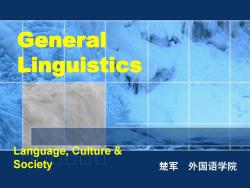
General Linguistics Language,Culture Society 楚军外国语学院
Language, Culture & Society 楚军 外国语学院 General Linguistics
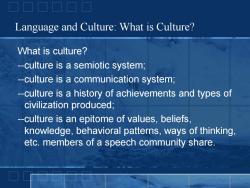
Language and Culture:What is Culture? What is culture? --culture is a semiotic system; --culture is a communication system; --culture is a history of achievements and types of civilization produced; --culture is an epitome of values,beliefs, knowledge,behavioral patterns,ways of thinking, etc.members of a speech community share
Language and Culture: What is Culture? What is culture? --culture is a semiotic system; --culture is a communication system; --culture is a history of achievements and types of civilization produced; --culture is an epitome of values, beliefs, knowledge, behavioral patterns, ways of thinking, etc. members of a speech community share

Language and Culture:What is Culture? Another definition of culture: --Culture is defined as the deposit of knowledge, experience,beliefs,values,actions,attitudes, meanings,hierarchies,religion,notions of time, roles,spatial relations,concepts of the universe,and artifacts acquired by a group of people in the course of generations through individual and group striving efforts
Language and Culture: What is Culture? Another definition of culture: --Culture is defined as the deposit of knowledge, experience, beliefs, values, actions, attitudes, meanings, hierarchies, religion, notions of time, roles, spatial relations, concepts of the universe, and artifacts acquired by a group of people in the course of generations through individual and group striving efforts

Language and Culture:What is Culture? .Major characteristics of culture: 1)Culture is learned (through proverbs,folk tales, legends,myths,art,mass media); 2)Culture is transmitted from generation to generation; 3)Culture is based on symbols; 4)Culture is subject to change; 5)Culture is integrated; 6)Culture is ethnocentric; 7)Culture is adaptive
Language and Culture: What is Culture? • Major characteristics of culture: 1) Culture is learned (through proverbs, folk tales, legends, myths, art, mass media); 2) Culture is transmitted from generation to generation; 3) Culture is based on symbols; 4) Culture is subject to change; 5) Culture is integrated; 6) Culture is ethnocentric; 7) Culture is adaptive
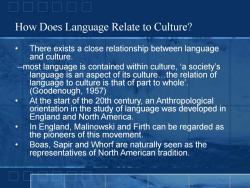
How Does Language Relate to Culture? There exists a close relationship between language and culture. --most language is contained within culture,'a society's language is an aspect of its culture...the relation of language to culture is that of part to whole'. (Goodenough,1957) At the start of the 20th century,an Anthropological orientation in the study of language was developed in England and North America. In England,Malinowski and Firth can be regarded as the pioneers of this movement. Boas,Sapir and Whorf are naturally seen as the representatives of North American tradition
How Does Language Relate to Culture? • There exists a close relationship between language and culture. --most language is contained within culture, ‘a society’s language is an aspect of its culture…the relation of language to culture is that of part to whole’. (Goodenough, 1957) • At the start of the 20th century, an Anthropological orientation in the study of language was developed in England and North America. • In England, Malinowski and Firth can be regarded as the pioneers of this movement. • Boas, Sapir and Whorf are naturally seen as the representatives of North American tradition

How Does Language Relate to Culture? In the 1920's,a school of Anthropological study of linguistics appeared in England: --Malinowski's field work on the Trobriand Island off eastern New Guinea paved the way for a cultural,rather,contextual study of language in England.(p.361) --Firth,a leading figure in London School, developed his theory of Context of Situation. (p.361)
How Does Language Relate to Culture? • In the 1920’s, a school of Anthropological study of linguistics appeared in England: --Malinowski’s field work on the Trobriand Island off eastern New Guinea paved the way for a cultural, rather, contextual study of language in England. (p.361) --Firth, a leading figure in London School, developed his theory of Context of Situation. (p.361)
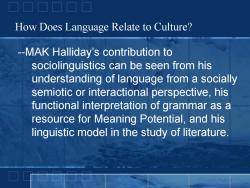
How Does Language Relate to Culture? --MAK Halliday's contribution to sociolinguistics can be seen from his understanding of language from a socially semiotic or interactional perspective,his functional interpretation of grammar as a resource for Meaning Potential,and his linguistic model in the study of literature
How Does Language Relate to Culture? --MAK Halliday’s contribution to sociolinguistics can be seen from his understanding of language from a socially semiotic or interactional perspective, his functional interpretation of grammar as a resource for Meaning Potential, and his linguistic model in the study of literature

How Does Language Relate to Culture? In North America,from the 1920's to 1940's,in the task of reconstruction of American native languages,anthropologists such as Boas,Sapir and Whorf came to know the significance of culture in the study of language use. Their work greatly influenced the development of the Ethnography of Communication-an authoritative research framework of our time in a linguistic study of social and cultural factors
How Does Language Relate to Culture? • In North America, from the 1920’s to 1940’s, in the task of reconstruction of American native languages, anthropologists such as Boas, Sapir and Whorf came to know the significance of culture in the study of language use. • Their work greatly influenced the development of the Ethnography of Communication—an authoritative research framework of our time in a linguistic study of social and cultural factors

How Does Language Relate to Culture? Sapir-Whorf Hypothesis: --our language helps mould our way of thinking and consequently,different languages may probably express our unique ways of understanding the world. Linguistic determinism:language may determine our thinking patterns; Linguistic relativism:similarity between languages is relative,the greater their structural differentiation is,the more diverse their conceptualization of the world will be
How Does Language Relate to Culture? • Sapir-Whorf Hypothesis: --our language helps mould our way of thinking and , consequently, different languages may probably express our unique ways of understanding the world. Linguistic determinism: language may determine our thinking patterns; Linguistic relativism: similarity between languages is relative, the greater their structural differentiation is, the more diverse their conceptualization of the world will be
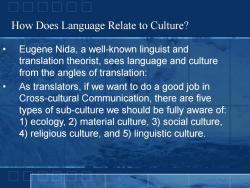
How Does Language Relate to Culture? Eugene Nida,a well-known linguist and translation theorist,sees language and culture from the angles of translation: As translators,if we want to do a good job in Cross-cultural Communication,there are five types of sub-culture we should be fully aware of: 1)ecology,2)material culture,3)social culture, 4)religious culture,and 5)linguistic culture
How Does Language Relate to Culture? • Eugene Nida, a well-known linguist and translation theorist, sees language and culture from the angles of translation: • As translators, if we want to do a good job in Cross-cultural Communication, there are five types of sub-culture we should be fully aware of: 1) ecology, 2) material culture, 3) social culture, 4) religious culture, and 5) linguistic culture
按次数下载不扣除下载券;
注册用户24小时内重复下载只扣除一次;
顺序:VIP每日次数-->可用次数-->下载券;
- 电子科技大学:《语言学通论 General Linguistics》课程教学资源(课件讲稿)语义学——Sentence meaning(Predication Analysis).pdf
- 电子科技大学:《语言学通论 General Linguistics》课程教学资源(课件讲稿)语义学——Componential Analysis.pdf
- 电子科技大学:《语言学通论 General Linguistics》课程教学资源(课件讲稿)语义学——Context, changes in word meaning, figures of speech.pdf
- 电子科技大学:《语言学通论 General Linguistics》课程教学资源(课件讲稿)语义学——Semantics(Sense Relations).pdf
- 电子科技大学:《语言学通论 General Linguistics》课程教学资源(课件讲稿)语义学——Types of word-meaning.pdf
- 电子科技大学:《语言学通论 General Linguistics》课程教学资源(课件讲稿)07 Semantics(Introduction).pdf
- 电子科技大学:《语言学通论 General Linguistics》课程教学资源(课件讲稿)06 Functional Grammar.pdf
- 电子科技大学:《语言学通论 General Linguistics》课程教学资源(课件讲稿)05 句法 Syntax.pdf
- 电子科技大学:《语言学通论 General Linguistics》课程教学资源(课件讲稿)04 Formalist Approach.pdf
- 电子科技大学:《语言学通论 General Linguistics》课程教学资源(课件讲稿)03 Formalist Approach.pdf
- 电子科技大学:《语言学通论 General Linguistics》课程教学资源(课件讲稿)02 句法 Syntax.pdf
- 电子科技大学:《语言学通论 General Linguistics》课程教学资源(课件讲稿)01 Introduction(主讲:楚军).pdf
- 山东省“成人教育特色课程”项目配套教材:《大学语文》课程教材电子版(主编:戴永新).pdf
- 聊城大学:《大学语文》课程教学资源(阅读文献)中国现当代文学经典作品选.pdf
- 聊城大学:《大学语文》课程教学资源(阅读文献)外国文学经典作品选.pdf
- 聊城大学:《大学语文》课程教学资源(阅读文献)中国古代文学经典作品选.pdf
- 聊城大学:《大学语文》课程教学资源(电子教案讲义,共十五讲).docx
- 运城学院:《文学概论 literature theory》课程教学资源(电子教案,打印版,2/2,共两编八章).pdf
- 运城学院:《文学概论 literature theory》课程教学资源(电子教案,打印版,1/2,共三篇八章).pdf
- 运城学院:《文学概论 literature theory》课程教学资源(教学大纲,打印版).pdf
- 电子科技大学:《语言学通论 General Linguistics》课程教学资源(课件讲稿)09 Pragmatics(Utterance Meaning).pdf
- 电子科技大学:《语言学通论 General Linguistics》课程教学资源(课件讲稿)形态学 Morphology.pdf
- 电子科技大学:《语言学通论 General Linguistics》课程教学资源(课件讲稿)认知语言学中的相关话题 Cognitive Linguistics.pdf
- 弟子规(全文).pdf
- 《中国语言文化 Chinese Language and Culture》课程教学资源(书籍阅读材料)《中国古典哲学名著选读》郭齐勇.pdf
- 《中国语言文化 Chinese Language and Culture》课程教学资源(书籍阅读材料)《唐诗三百首》中英文对照(许渊冲)300 Tang Poems(Classified by Theme).pdf
- 《中国语言文化 Chinese Language and Culture》课程教学资源(书籍阅读材料)《二十四诗品校注译评》祖保泉.pdf
- 《中国语言文化 Chinese Language and Culture》课程教学资源(书籍阅读材料)《近代中国之种族观念》刘东.pdf
- 《中国语言文化 Chinese Language and Culture》课程教学资源(书籍阅读材料)《中国现代女作家与中国革命1905-1948》颜海平.pdf
- 《中国语言文化 Chinese Language and Culture》课程教学资源(书籍阅读材料)《世界秩序与文明等级》全球史研究的新路径(主编:刘禾).pdf
- 《中国语言文化 Chinese Language and Culture》课程教学资源(书籍阅读材料)《叫魂》SOULSTEALERS - The Chinese Sorcery Scare of 1768〔美〕孔飞力(1768年中国妖术大恐慌).pdf
- 电子科技大学:《中国语言文化 Chinese Language and Culture》课程教学资源(课件讲稿)导论(聂韬).pdf
- 电子科技大学:《中国语言文化 Chinese Language and Culture》课程教学资源(课件讲稿)第一讲 周易.pdf
- 电子科技大学:《中国语言文化 Chinese Language and Culture》课程教学资源(课件讲稿)第七讲 谶纬之学.pdf
- 电子科技大学:《中国语言文化 Chinese Language and Culture》课程教学资源(课件讲稿)第三讲 山海经.pdf
- 电子科技大学:《中国语言文化 Chinese Language and Culture》课程教学资源(课件讲稿)第二讲 尚书.pdf
- 电子科技大学:《中国语言文化 Chinese Language and Culture》课程教学资源(课件讲稿)第五讲 道家与魏晋风度.pdf
- 电子科技大学:《中国语言文化 Chinese Language and Culture》课程教学资源(课件讲稿)第八讲 诗歌的创作翻译与批评之平仄格律.pdf
- 电子科技大学:《中国语言文化 Chinese Language and Culture》课程教学资源(课件讲稿)第六讲 汉赋(中国古代辞赋).pdf
- 电子科技大学:《中国语言文化 Chinese Language and Culture》课程教学资源(课件讲稿)第九讲 中国与性别文学(古代女性创作的基本内容).pdf
